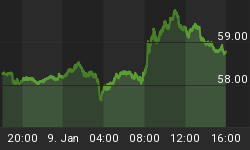When prices fluctuate in a smaller range over time a triangle formation occurs. Triangle patterns are some of the best trading opportunities in financial markets.
Our favorite aspect of triangles is that they usually retrace beyond the standard 61.8% Fibonacci retracement level and hurt traders. By Elliott Wave terms, we also see a "wave E" break of both trendline resistance/support and the 61.8% Fibonacci level.
This does two things. First it hits stops and sees a surge in breakout buying. Second, that mass movement by the market sets up the reversal point in "wave E" which then catches the market wrong footed again. Fun!
Identifying triangle patterns usually only comes about near the apex in "wave E" so experienced traders know to be very cautious as whipsaw movement is the standard for these formations. Interestingly, the currency markets currently have two major pairs in long term triangle patterns. Let's look at each of these.
First is USDJPY which we believe is going to see a typical "false breakout" in "wave E of IV" in this triangle formation. That would likely mean a move to 1.24/25 (just above the 61.8% Fib of the wave C to D decline). Then a sharp reversal over the first several months of 2007 as the JGB market declines rapidly in line with a move higher in rates. We will look to buy JPY once we reach "wave E."

USDJPY fundamental picture is very much in line with the technically bearish descending triangle formation, supporting our forecast of near term yen weakness followed by a sharp rebound. After years of quantitative easing and months of Zero Interest Rate Policy, the Bank of Japan had finally taken a first step toward removing the extreme accommodation and raised interest rates to 0.25%. However, the month of August saw nothing but negative economic data from Japan. Among the most notable figures were a decline in Q2 GDP from 0.8% all the way to near-recession levels at 0.2%, a drop in new housing starts from nearly 7% to 4%, and finally a shortfall in core CPI from 0.6% to 0.2%. As a result, speculation over further central bank tightening has diminished significantly with both currency and JGB markets seeing declines in yen and a rally in bonds. Years of "free money" have set up a climate of inevitable recovery, however just as the central bankers from Japan have warned us, that recovery will be far more gradual than the impatient markets were expecting.
Another major pair putting on the finishing touches of "wave E of IV" is EURGBP. This is a bullish triangle formation from the May 2003 highs and has the classic EW "ABCDE" count in what is typically a "wave IV" consolidation. While a bit unconventional, we prefer to buy near the "puke point" in "wave E" which is the May '05 "wave C" low at 0.66. That means traders should buy here this week at 0.6740 (s/l @ 0.66 and target at 0.77) for a 7:1 reward to risk ratio.

Fundamentally, we find a comparable to Japan windfall of deterioration in economic data coming in from the UK to be just as compelling. Sharp declines in manufacturing and industrial production were followed by data showing diminishing inflationary pressures. After a surprise rate hike last month, the Bank of England monetary policy committee will restore its conservative approach to monetary policy with a hold on interest rates at 4.75% on September 7th.
The euro side of the EURGBP coin is far more attractive. After a slight stumble in the ZEW survey as measured by industry analysts, the more reliable business manager sentiment IFO index showed a slight improvement. And while this week's ECB decision is unlikely to produce another rate hike, we expect central bank Governor Trichet to maintain the accelerated tightening pace and to once again signal further removal of accommodation at the next meeting in October. This development should continue to support the single currency that can now also be tracked via an ETF under a symbol "FXE".















